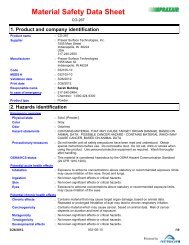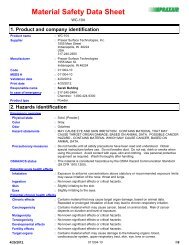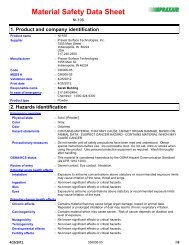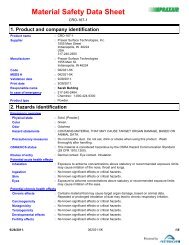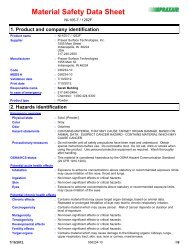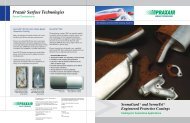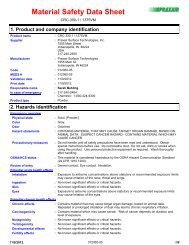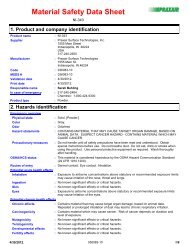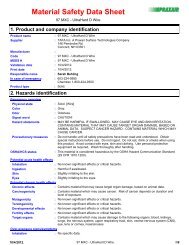NI-191-4 - Praxair Surface Technologies
NI-191-4 - Praxair Surface Technologies
NI-191-4 - Praxair Surface Technologies
Create successful ePaper yourself
Turn your PDF publications into a flip-book with our unique Google optimized e-Paper software.
Product nameSupplierManufacturerCodeMSDS #Validation datePrint dateMaterial Safety Data Sheet<strong>NI</strong>-<strong>191</strong>-41. Product and company identificationResponsible nameIn case of emergencyProduct type2. Hazards identificationPotential acute health effectsInhalationIngestionSkinEyes: <strong>NI</strong>-<strong>191</strong>-4: <strong>Praxair</strong> <strong>Surface</strong> <strong>Technologies</strong>, Inc.1555 Main StreetIndianapolis, IN 46224USA317-240-2650: <strong>Praxair</strong> <strong>Surface</strong> <strong>Technologies</strong>1555 Main St.Indianapolis, IN 46224: Z<strong>NI</strong><strong>191</strong>-0410: Z<strong>NI</strong><strong>191</strong>-0410: 11/9/2012.: 11/9/2012.: Sarah Behling: 317-240-2484Chemtrec: 1-800-424-9300: Powder.Emergency overviewPhysical state: Solid. [Powder.]Color: Gray.Odor: OdorlessHazard statements : CONTAINS MATERIAL THAT MAY CAUSE TARGET ORGAN DAMAGE, BASED ONA<strong>NI</strong>MAL DATA. SUSPECT CANCER HAZARD - CONTAINS MATERIAL WHICH MAYCAUSE CANCER.Precautionary measuresOSHA/HCS statusPotential chronic health effectsChronic effectsCarcinogenicityMutagenicityTeratogenicityDevelopmental effectsFertility effectsTarget organs: Do not handle until all safety precautions have been read and understood. Obtainspecial instructions before use. Do not breathe dust. Do not eat, drink or smoke whenusing this product. Use personal protective equipment as required. Wash thoroughlyafter handling.: This material is considered hazardous by the OSHA Hazard Communication Standard(29 CFR <strong>191</strong>0.1200).::::Exposure to airborne concentrations above statutory or recommended exposure limitsmay cause irritation of the nose, throat and lungs.No known significant effects or critical hazards.No known significant effects or critical hazards.Exposure to airborne concentrations above statutory or recommended exposure limitsmay cause irritation of the eyes.: Contains material that may cause target organ damage, based on animal data.Repeated or prolonged inhalation of dust may lead to chronic respiratory irritation.: Contains material which may cause cancer. Risk of cancer depends on duration andlevel of exposure.: No known significant effects or critical hazards.: No known significant effects or critical hazards.: No known significant effects or critical hazards.: No known significant effects or critical hazards.: Contains material which may cause damage to the following organs: kidneys, lungs, thenervous system, upper respiratory tract, skin, eye, lens or cornea, nose/sinuses.11/9/2012.Z<strong>NI</strong><strong>191</strong>-04101/9
<strong>NI</strong>-<strong>191</strong>-42. Hazards identificationOver-exposure signs/symptomsInhalationIngestionSkinEyesMedical conditionsaggravated by overexposureSee toxicological information (Section 11): Adverse symptoms may include the following:respiratory tract irritationcoughing: No specific data.: No specific data.: Adverse symptoms may include the following:irritationredness:Pre-existing disorders involving any target organs mentioned in this MSDS as being atrisk may be aggravated by over-exposure to this product.3. Composition/information on ingredientsName CAS number %Nickel 7440-02-0 20 - 50Cobalt 7440-48-4 20 - 50Chromium 7440-47-3 5 - 20Aluminium 7429-90-5 5 - 20Yttrium 7440-65-5
<strong>NI</strong>-<strong>191</strong>-45. Fire-fighting measuresSpecial exposure hazards :Hazardous thermaldecomposition productsSpecial protectiveequipment for fire-fighters6. Accidental release measuresPersonal precautions :Environmental precautionsMethods for cleaning upSmall spill :Large spill :7. Handling and storage:Promptly isolate the scene by removing all persons from the vicinity of the incident ifthere is a fire. No action shall be taken involving any personal risk or without suitabletraining.: Decomposition products may include the following materials:metal oxide/oxidesFire-fighters should wear appropriate protective equipment and self-contained breathingapparatus (SCBA) with a full face-piece operated in positive pressure mode.No action shall be taken involving any personal risk or without suitable training.Evacuate surrounding areas. Keep unnecessary and unprotected personnel fromentering. Do not touch or walk through spilled material. Avoid breathing dust. Provideadequate ventilation. Wear appropriate respirator when ventilation is inadequate. Puton appropriate personal protective equipment (see Section 8).: Avoid dispersal of spilled material and runoff and contact with soil, waterways, drainsand sewers. Inform the relevant authorities if the product has caused environmentalpollution (sewers, waterways, soil or air).Move containers from spill area. Vacuum or sweep up material and place in adesignated, labeled waste container. Dispose of via a licensed waste disposalcontractor.Move containers from spill area. Approach release from upwind. Prevent entry intosewers, water courses, basements or confined areas. Vacuum or sweep up materialand place in a designated, labeled waste container. Avoid creating dusty conditions andprevent wind dispersal. Dispose of via a licensed waste disposal contractor. Note: seesection 1 for emergency contact information and section 13 for waste disposal.HandlingStorage::Put on appropriate personal protective equipment (see Section 8). Eating, drinking andsmoking should be prohibited in areas where this material is handled, stored andprocessed. Workers should wash hands and face before eating, drinking and smoking.Remove contaminated clothing and protective equipment before entering eating areas.Avoid exposure - obtain special instructions before use. Do not get in eyes or on skin orclothing. Do not ingest. Avoid breathing dust. If during normal use the materialpresents a respiratory hazard, use only with adequate ventilation or wear appropriaterespirator. Keep in the original container or an approved alternative made from acompatible material, kept tightly closed when not in use. Empty containers retainproduct residue and can be hazardous. Do not reuse container.Store in accordance with local regulations. Store in original container protected fromdirect sunlight in a dry, cool and well-ventilated area, away from incompatible materials(see section 10) and food and drink. Keep container tightly closed and sealed until readyfor use. Containers that have been opened must be carefully resealed and kept uprightto prevent leakage. Do not store in unlabeled containers. Use appropriate containmentto avoid environmental contamination.8. Exposure controls/personal protectionIngredientExposure limitsNickel ACGIH TLV (United States, 2/2010). Notes: Refers to Appendix A --Carcinogens. Inhalable fraction. See Appendix C, paragraph A.Inhalable Particulate Mass TLVs (IPM–TLVs) for those materialsthat are hazardous when deposited anywhere in the respiratorytract. 1998 Adoption.TWA: 1.5 mg/m³ 8 hour(s). Form: Inhalable fraction<strong>NI</strong>OSH REL (United States, 6/2009). Notes: as NiTWA: 0.015 mg/m³, (as Ni) 10 hour(s).OSHA PEL (United States, 6/2010). Notes: as NiTWA: 1 mg/m³, (as Ni) 8 hour(s).11/9/2012.Z<strong>NI</strong><strong>191</strong>-04103/9
<strong>NI</strong>-<strong>191</strong>-48. Exposure controls/personal protectionOSHA PEL 1989 (United States, 3/1989). Notes: as NiTWA: 1 mg/m³, (as Ni) 8 hour(s).CobaltChromiumAluminium<strong>NI</strong>OSH REL (United States, 6/2009). Notes: as CoTWA: 0.05 mg/m³, (as Co) 10 hour(s). Form: Dust and fumesACGIH TLV (United States, 2/2010). Notes: as CoTWA: 0.02 mg/m³, (as Co) 8 hour(s). Form: InorganicOSHA PEL (United States, 6/2010). Notes: as CoTWA: 0.1 mg/m³, (as Co) 8 hour(s).OSHA PEL 1989 (United States, 3/1989). Notes: as CoTWA: 0.05 mg/m³, (as Co) 8 hour(s).ACGIH TLV (United States, 2/2010). Notes: measured as CrTWA: 0.5 mg/m³, (measured as Cr) 8 hour(s). Form: Inorganic<strong>NI</strong>OSH REL (United States, 6/2009). Notes: See Appendix C -Supplemental Exposure LimitsTWA: 0.5 mg/m³ 10 hour(s).OSHA PEL (United States, 6/2010). Notes: as CrTWA: 1 mg/m³, (as Cr) 8 hour(s).OSHA PEL 1989 (United States, 3/1989).TWA: 1 mg/m³ 8 hour(s).OSHA PEL 1989 (United States, 3/1989). Notes: as AlTWA: 15 mg/m³, (as Al) 8 hour(s). Form: DustTWA: 5 mg/m³, (as Al) 8 hour(s). Form: PyrophoricTWA: 5 mg/m³, (as Al) 8 hour(s). Form: Respirable fractionTWA: 5 mg/m³, (as Al) 8 hour(s). Form: Welding fumeOSHA PEL (United States, 6/2010). Notes: as AlTWA: 5 mg/m³, (as Al) 8 hour(s). Form: Respirable fractionTWA: 15 mg/m³, (as Al) 8 hour(s). Form: Total dust<strong>NI</strong>OSH REL (United States, 6/2009).TWA: 5 mg/m³ 10 hour(s). Form: Respirable fractionTWA: 10 mg/m³ 10 hour(s). Form: TotalACGIH TLV (United States, 2/2010).TWA: 1 mg/m³ 8 hour(s). Form: Respirable fractionRecommended monitoringproceduresEngineering measuresHygiene measuresPersonal protectionRespiratoryHands :EyesSkin11/9/2012.: If this product contains ingredients with exposure limits, personal, workplace atmosphereor biological monitoring may be required to determine the effectiveness of the ventilationor other control measures and/or the necessity to use respiratory protective equipment.: Use only with adequate ventilation. If user operations generate dust, fumes, gas, vaporor mist, use process enclosures, local exhaust ventilation or other engineering controlsto keep worker exposure to airborne contaminants below any recommended or statutorylimits.: Wash hands, forearms and face thoroughly after handling chemical products, beforeeating, smoking and using the lavatory and at the end of the working period. Appropriatetechniques should be used to remove potentially contaminated clothing. Washcontaminated clothing before reusing. Ensure that eyewash stations and safety showersare close to the workstation location.:::Use a properly fitted, air-purifying or air-fed respirator complying with an approvedstandard if a risk assessment indicates this is necessary. Respirator selection must bebased on known or anticipated exposure levels, the hazards of the product and the safeworking limits of the selected respirator.Chemical-resistant, impervious gloves complying with an approved standard should beworn at all times when handling chemical products.Safety eyewear complying with an approved standard should be used when a riskassessment indicates this is necessary to avoid exposure to liquid splashes, mists ordusts. If operating conditions cause high dust concentrations to be produced, use dustgoggles.Personal protective equipment for the body should be selected based on the task beingperformed and the risks involved and should be approved by a specialist before handlingthis product.Z<strong>NI</strong><strong>191</strong>-04104/9
<strong>NI</strong>-<strong>191</strong>-48. Exposure controls/personal protectionEnvironmental exposurecontrols: Emissions from ventilation or work process equipment should be checked to ensure theycomply with the requirements of environmental protection legislation. In some cases,fume scrubbers, filters or engineering modifications to the process equipment will benecessary to reduce emissions to acceptable levels.9. Physical and chemical propertiesPhysical state:Color:Odor:Distribution:Melting/freezing point :VOC content :Solubility:Solid. [Powder.]Gray.Odorless-45/+16u1455°C (2651°F)0 lbs/gal (0 g/l)Insoluble in the following materials: cold water and hot water.10. Stability and reactivityChemical stabilityConditions to avoidIncompatible materialsHazardous decompositionproductsPossibility of hazardousreactions: The product is stable.: No specific data.: No specific data.: Under normal conditions of storage and use, hazardous decomposition products shouldnot be produced.: Under normal conditions of storage and use, hazardous reactions will not occur.11. Toxicological informationAcute toxicityConclusion/SummaryChronic toxicityConclusion/SummaryIrritation/CorrosionConclusion/SummarySensitizerConclusion/SummaryCarcinogenicityConclusion/SummaryClassification: Not available.: Not available.: Not available.: Not available.: Not available.Product/ingredient name ACGIH IARC EPA <strong>NI</strong>OSH NTPNickel A5 2B - + Possible -Cobalt A3 2B - - - -Chromium A4 3 - - - -Aluminium A4 - - - - -OSHAMutagenicityConclusion/SummaryTeratogenicityConclusion/SummaryReproductive toxicityConclusion/Summary: Not available.: Not available.: Not available.11/9/2012.Z<strong>NI</strong><strong>191</strong>-04105/9
<strong>NI</strong>-<strong>191</strong>-412. Ecological informationEcotoxicity: No known significant effects or critical hazards.Aquatic ecotoxicityProduct/ingredient name ResultSpeciesExposureNickel Acute EC50 450 ug/L Fresh water Aquatic plants - Lemna minor 4 daysAcute EC50 1000 ug/L Marine water Daphnia - Daphnia magna -
<strong>NI</strong>-<strong>191</strong>-414. Transport informationPG* : Packing group15. Regulatory informationHCS ClassificationU.S. Federal regulations::CarcinogenTarget organ effectsTSCA 8(a) IUR Exempt/Partial exemption: Not determinedUnited States inventory (TSCA 8b): All components are listed or exempted.SARA 302/304/311/312 extremely hazardous substances: No products were found.SARA 302/304 emergency planning and notification: No products were found.SARA 302/304/311/312 hazardous chemicals: Nickel; Cobalt; AluminiumSARA 311/312 MSDS distribution - chemical inventory - hazard identification:Nickel: Fire hazard, Immediate (acute) health hazard, Delayed (chronic) health hazard;Cobalt: Delayed (chronic) health hazard; Aluminium: Fire hazard, reactiveClean Water Act (CWA) 307: Nickel; ChromiumClean Air Act Section112(b) Hazardous AirPollutants (HAPs)Clean Air Act Section 602Class I SubstancesClean Air Act Section 602Class II SubstancesDEA List I Chemicals(Precursor Chemicals)DEA List II Chemicals(Essential Chemicals): Not listed: Not listed: Not listed: Not listed: Not listedSARA 313Product name CAS number ConcentrationForm R - ReportingrequirementsSupplier notificationNickel 7440-02-0 20 - 50Cobalt 7440-48-4 20 - 50Chromium 7440-47-3 5 - 20Aluminium 7429-90-5 5 - 20Nickel 7440-02-0 20 - 50Cobalt 7440-48-4 20 - 50Chromium 7440-47-3 5 - 20Aluminium 7429-90-5 5 - 20SARA 313 notifications must not be detached from the MSDS and any copying and redistribution of the MSDS shallinclude copying and redistribution of the notice attached to copies of the MSDS subsequently redistributed.State regulationsMassachusettsNew YorkNew JerseyPennsylvania:The following components are listed: <strong>NI</strong>CKEL; COBALT; CHROMIUM; ALUMINUM: The following components are listed: Nickel; Chromium: The following components are listed: <strong>NI</strong>CKEL; COBALT; CHROMIUM; ALUMINUM: The following components are listed: <strong>NI</strong>CKEL; COBALT FUME; CHROMIUM;ALUMINUMCalifornia Prop. 65WAR<strong>NI</strong>NG: This product contains a chemical known to the State of California to cause cancer.Ingredient name Cancer Reproductive No significant risklevelMaximumacceptable dosagelevelNickel Yes. No. No. No.Cobalt Yes. No. No. No.11/9/2012.Z<strong>NI</strong><strong>191</strong>-04107/9
<strong>NI</strong>-<strong>191</strong>-415. Regulatory informationCanada inventoryInternational regulationsInternational lists :Chemical WeaponsConvention List Schedule IChemicalsChemical WeaponsConvention List ScheduleII ChemicalsChemical WeaponsConvention List ScheduleIII Chemicals16. Other information: All components are listed or exempted.Australia inventory (AICS): Not determined.China inventory (IECSC): All components are listed or exempted.Japan inventory: Not determined.Korea inventory: All components are listed or exempted.New Zealand Inventory of Chemicals (NZIoC): All components are listed or exempted.Philippines inventory (PICCS): Not determined.: Not listed: Not listed: Not listedLabel requirements :Hazardous MaterialInformation System (U.S.A.):CONTAINS MATERIAL THAT MAY CAUSE TARGET ORGAN DAMAGE, BASED ONA<strong>NI</strong>MAL DATA. SUSPECT CANCER HAZARD - CONTAINS MATERIAL WHICH MAYCAUSE CANCER.HealthFlammabilityPhysical hazards100Caution: HMIS® ratings are based on a 0-4 rating scale, with 0 representing minimal hazards or risks, and 4representing significant hazards or risks Although HMIS® ratings are not required on MSDSs under 29 CFR<strong>191</strong>0.1200, the preparer may choose to provide them. HMIS® ratings are to be used with a fully implementedHMIS® program. HMIS® is a registered mark of the National Paint & Coatings Association (NPCA). HMIS®materials may be purchased exclusively from J. J. Keller (800) 327-6868.The customer is responsible for determining the PPE code for this material.National Fire ProtectionAssociation (U.S.A.):Health100FlammabilityInstability/ReactivitySpecialReprinted with permission from NFPA 704-2001, Identification of the Hazards of Materials for EmergencyResponse Copyright ©1997, National Fire Protection Association, Quincy, MA 02269. This reprinted material is notthe complete and official position of the National Fire Protection Association, on the referenced subject which isrepresented only by the standard in its entirety.Copyright ©2001, National Fire Protection Association, Quincy, MA 02269. This warning system is intended to beinterpreted and applied only by properly trained individuals to identify fire, health and reactivity hazards ofchemicals. The user is referred to certain limited number of chemicals with recommended classifications in NFPA49 and NFPA 325, which would be used as a guideline only. Whether the chemicals are classified by NFPA or not,anyone using the 704 systems to classify chemicals does so at their own risk.Date of printingDate of issueDate of previous issue:::11/9/2012.11/9/2012.No previous validation.11/9/2012.Z<strong>NI</strong><strong>191</strong>-04108/9
<strong>NI</strong>-<strong>191</strong>-416. Other informationVersion : 2Prepared by : 1.0Indicates information that has changed from previously issued version.Notice to readerTo the best of our knowledge, the information contained herein is accurate. However, neither the above-namedsupplier, nor any of its subsidiaries, assumes any liability whatsoever for the accuracy or completeness of theinformation contained herein.Final determination of suitability of any material is the sole responsibility of the user. All materials may presentunknown hazards and should be used with caution. Although certain hazards are described herein, we cannotguarantee that these are the only hazards that exist.11/9/2012.Z<strong>NI</strong><strong>191</strong>-04109/9



